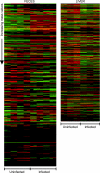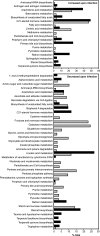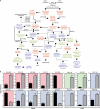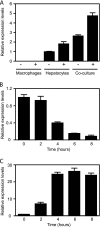Impact of salmonella infection on host hormone metabolism revealed by metabolomics
- PMID: 21321075
- PMCID: PMC3067560
- DOI: 10.1128/IAI.01373-10
Impact of salmonella infection on host hormone metabolism revealed by metabolomics
Abstract
The interplay between pathogens and their hosts has been studied for decades using targeted approaches, such as the analysis of mutants and host immunological responses. Although much has been learned from such studies, they focus on individual pathways and fail to reveal the global effects of infection on the host. To alleviate this issue, high-throughput methods, such as transcriptomics and proteomics, have been used to study host-pathogen interactions. Recently, metabolomics was established as a new method to study changes in the biochemical composition of host tissues. We report a metabolomic study of Salmonella enterica serovar Typhimurium infection. Our results revealed that dozens of host metabolic pathways are affected by Salmonella in a murine infection model. In particular, multiple host hormone pathways are disrupted. Our results identify unappreciated effects of infection on host metabolism and shed light on mechanisms used by Salmonella to cause disease and by the host to counter infection.
Figures










References
-
- Bearson, B. L., and S. M. Bearson. 2008. The role of the QseC quorum-sensing sensor kinase in colonization and norepinephrine-enhanced motility of Salmonella enterica serovar Typhimurium. Microb. Pathog. 44:271-278. - PubMed
-
- Calder, P. C. 2009. Polyunsaturated fatty acids and inflammatory processes: new twists in an old tale. Biochimie 91:791-795. - PubMed
-
- Cooles, P. 1986. Adjuvant steroids and relapse of typhoid fever. J. Trop. Med. Hyg. 89:229-231. - PubMed
-
- Daynes, R. A., B. A. Araneo, J. Hennebold, E. Enioutina, and H. H. Mu. 1995. Steroids as regulators of the mammalian immune response. J. Investig. Dermatol. 105:14S-19S. - PubMed
Publication types
MeSH terms
Associated data
- Actions
Grants and funding
LinkOut - more resources
Full Text Sources
Molecular Biology Databases

